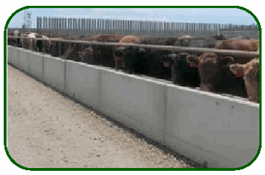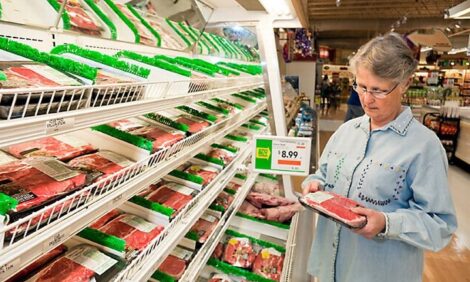



Some Feeding Tips For Tough Times
By Janette Richards, Acting Beef Feedlot Specialist, OMAFRA. - Cattle feeding costs are high. Since feed costs can account for 80% of the variable cost of production (about 60% of the total costs), any changes to ration cost can have a huge impact on profitability.This being the case, you need to make sure that you’re feeding the most economical ration that you can. Here are some tips to help you get the best value out of your feeding program.
Protein Levels:
 |
| Figure 1: Feed Can Account For 80% of Variable Feedlot Costs |
Overfeeding protein will cost you money. A 1,000 lb steer consuming about 10 kg (22 lb) of Dry Matter and a 12% Crude Protein Ration would consume about 1.2 kg of protein per head per day. If you are feeding a ration that provides 13% Crude Protein, then this is equal to around 0.21 kg of extra 48% soybean meal per head per day.
At $425.00 per tonne for soymeal, this adds up to about 8.85 cents/head/day. This may not sound like much, but if you are feeding 200 head for 165 days, it adds up – to just over $2,900.00. There are there are other protein sources that are more economical than 48% SBM – but it did get your attention! The fact of the matter is, if you are overfeeding protein, it is costing you money!
Are You Feeding Urea – and Are You Feeding Enough?
Urea is a great source of non protein nitrogen (NPN) for beef feedlot animals. When fed as part of a balanced ration, urea is converted by rumen microbes into true protein, which the animal can utilize. While urea can’t be the only protein source you feed, it should be incorporated into finishing rations. How much urea you can feed depends on a few things, such as if you are feeding other sources of NPN, like ammoniated corn silage – but in general 100 grams per head per day is not unreasonable for finishing animals. It is your cheapest source of protein, so make sure that you are using some. Work with your nutritionist to determine the best feeding rate for your operation.
Phosphorus Levels:
 |
| Figure 2: Urea Can Be An Economical Supplement In Many Feedlot Diets |
Many rations contain high levels of corn grain or corn processing products such as distillers grains or gluten. These provide rich sources of phosphorus. With the recent increases in phosphate prices, overfeeding phosphorous could be costing you more than you think. Make sure that your supplement or trace mineral package is properly designed for your rations. If your ration contains higher levels of corn, distillers or gluten, you may need very little additional phosphorous.
Feed Additives – Medications and Others:
Not all of your ration additives may be necessary and they may not always consistently enhance your performance. To be cost effective, any additive must consistently improve your feed conversion, average daily gain or carcass merit. Additives should be evaluated based on their return on investment and you need to question whether they are really worth the added expense. What do these additives cost/head/day and are they putting money in YOUR pocket?
Alternative Feed Ingredients:
There may be some alternative ingredients that are available in your area. The biggest question always is are they cost effective? As with any feed ingredient, the price and nutrient content of these alternative feeds will need to be evaluated before you purchase. In order to help you figure this out, OMAFRA has put together a Factsheet – Comparative Feed Values for Ruminants, order no. 03-005 which can be found at:
http://www.omafra.gov.on.ca/english/livestock/d airy/facts/03-005.htm
At the bottom of the Factsheet, there is a link to “An Interactive Version of Petersen’s Equations”. Petersen's equations are used to calculate the value of alternative feeds based on their combined protein and energy contents in comparison to the nutritive values and costs of corn and soybean meal. It should be noted that Petersen's equations do not accurately evaluate feeds that are mainly suppliers of fiber, by-pass protein, fat or phosphorus. Other considerations such as palatability, digestibility, nutritional variation, storage costs, shrink, “shelf-life”, transportation and/or handling challenges are NOT taken into consideration. However, it will provide you with a fairly quick answer as to whether or not you should consider incorporating this alternative ingredient into your ration. If it looks good, contact your feed company and ask them to look at some rations for you in order to get a better handle on the potential cost savings to your operation.
There is no “quick fix” for these high feed prices. But what you need to do is evaluate all aspects of your feeding program in order to help you figure out where you may be able to save some money. Work with your nutritionist and/or feed company and get your feeds and rations tested. The savings you may realize from some minor ration adjustments could easily cover the cost of the analysis, while putting some additional money back into your pocket.
May 2008


